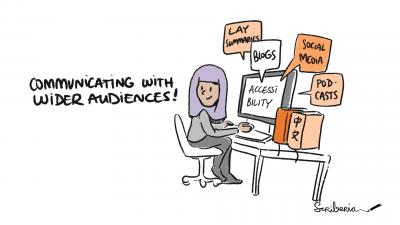Making your research outputs accessible to wider audiences
Posted on 7 July 2021
Making your research outputs accessible to wider audiences
 Created by Scriberia for The Turing Way community.
Created by Scriberia for The Turing Way community.CC-BY. https://doi.org/10.5281/zenodo.3332807
By Emma Karoune, Maria Nanton and Marta Mangiarulo - written on behalf of The Turing Way Community.
As specialists in a research domain or producing software for research, we must appreciate that many of our research outputs are extremely technical in terms of the language we use and the writing styles we follow. They are also likely to be published on academic platforms, such as domain-specific journals, which are often inaccessible to the public, and sometimes even academics.
With this type of communication approach, we end up excluding others from accessing our research, and hence, we need to think carefully about how we can open up our work to wider audiences. We should consider how we document our work, how we write about the research we are doing to communicate progress and results, and how we give others access to our outputs.
With greater consideration to accessibility, we can increase the audiences that will read and hear our outputs. This will ultimately build a more sustainable future for research that has a positive impact on society.
The Turing Way project has recently published six new chapters in the Guide for Communication that focuses on communicating with wider audiences. We (the authors of this blog post) worked on those chapters with a motivation to stimulate thoughtful discussions and understanding of improving accessibility in research outputs. We discuss different ways of writing about research objects that we want to share, preparing presentations for a wider range of events and considering disability-related requirements for different audiences.
These new chapters have information to get you started with writing blogs, podcasts, lay summaries, giving presentations outside of your discipline and using social media. There are resources, practical advice and personal anecdotes describing how one goes about using communication tools.
Many of the chapters also include case studies from prominent researchers with experience in these different science communication methods such as Emma Harris and Zoe Ingram from the Orion Open Science Podcast. These interviews contain personal stories about how they got started, mistakes avoid and their top tips.
Useful tips for communicating with wider audiences
1. Know your audience
Any good piece of science communication must have a target audience.
Think about who you want to reach and who you are speaking or writing for.
Knowing your audience determines how you are going to write. It makes it easier for you to identify the level of technical details for your audience, special adjustments you need to make for them, and the best ways to share/publish your output.
When you intend your work to be read or heard by different sets of audiences, consider all possible accessibility aspects that will make this happen for you.
2. Make it informal
Communicating with wider audiences often means adapting your work into a less formal and less technical style. Your choice of the communication channels can determine this style, for example, use a more accessible and friendly writing style for blog-based project updates compared to how you would write an article of preliminary results for an academic journal. But they are essentially giving the same information, just in a different way.
Blogs can increase awareness of your work and build momentum in a project leading to better impact overall. They can be used to advertise events that you have run and promote more specialist publications.
You can find out more about writing blogs by reading our chapter on Blogs for Research Communication.
3. Banish the jargon
You might think that using specialist words or acronyms makes your work appear more professional or academic. Many disciplines have certain terms that are specific to their field, but this means they are often only understood by people within this group.
In terms of science communication, this subject-specific jargon is gibberish to anyone not within your discipline. It excludes many people, even other researchers, from accessing your work. Therefore, it is best to banish all the jargon in your writing by replacing it with terms that are easier to understand. Sometimes this is hard or impossible to do, so in this case, you can explain the terms or use web links to indicate where further information can be found.
4. Think about where you are communicating
This is an important tip for reaching the audience that you want to engage. It might mean that you choose certain blogging websites or social media channels to get your research out to the people you want to reach.
It’s best to make your research outputs free to access - this will have a positive effect both in terms of the number of people your content can reach and the impact it can generate.
Even if you participate in events like a fee-based conference or workshop, which limits accessibility, you can always publish presentations, posters or materials in open repositories. Have a look at our section on sharing presentations to help you do this and also our chapter on making research objects citable so that it is easy for others to give you credit for your outputs.
5. Communicate inclusively
Making your work accessible to broad audiences involves ensuring its accessibility to people with disabilities. This aspect involves using captions, alternative text, and evaluating the visuals, such as colour schemes to ensure accessibility for people with colour blindness.
Translating is also an inclusive communication practice. In addition to ensuring that all your communications are available in English, it can be very beneficial to translate materials into other languages to increase their reach and usability for multiple audiences.
Related to the above, aspects such as using captions in your videos and audio-based materials are also beneficial for audiences for whom English is a second language. You can read more about this topic in The Turing Way Guide for Communication.
The Turing Way also includes guides about reproducible research, project design, collaboration and ethical research.

